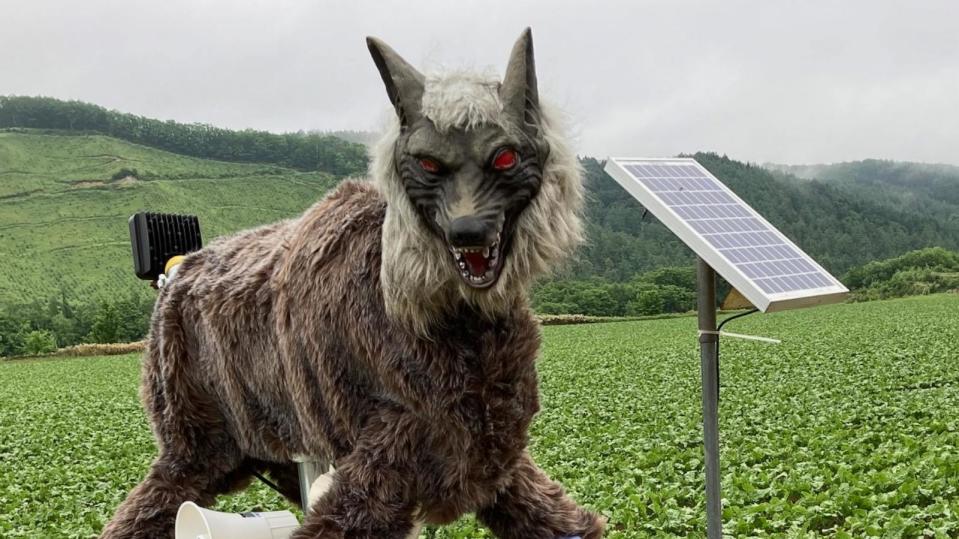By ANTHONY TROTTER

Amid the tranquil landscapes of Japan, where the haunting howls of real wolves fell silent in the echoes of the past, an eerily familiar sound now resounds.
“You’re not getting away with this!” warns the synthetic wolf in a chilling human voice at 60 decibels.
Its mechanical neck swivels, a movement akin to a living creature scanning its territory. A blend of tech and tradition, it’s designed not to fool humans, yet terrify potential pests.
An evolution in defense, Monster Wolf, bearing lifelike proportions and glowing red LED eyes, emerges as a testament to human ingenuity. It stands as a guardian at the crossroads of technology and tradition, confronting wildlife intrusions into human domains. Beyond its role as a 21st-century scarecrow, Monster Wolf stands as a symbol of adaptation in a world, offering a modern response to age-old challenges.
As Japan grapples with the consequences of dwindling natural predators, the nation sees an increasing encroachment of animals — like deer, wild boars, monkeys and bears — into human territories. Deer and boars, in particular, can wreak havoc on agricultural produce, while encounters between humans and monkeys or bears can escalate into dangerous confrontations.
“It’s been a success,” confirms Yuji Ohta, from Ohta Seiki, the innovative minds behind this 21st-century, non-lethal guardian.
Ohta boasts of his creation, “To date, no one has questioned its effectiveness, nor have we faced any returns due to dissatisfaction.”
About 180 Monster Wolves have been deployed across the country, Ohta told ABC News. Their primary task? Presenting a formidable, albeit artificial, deterrent to these creatures and filling the void left by their vanished natural enemies. According to Ohta Monster Wolf can be useful on golf courses, near highway entrances, and railroad crossings.
“I think it’s much more cost-effective to threaten with a machine and drive it away from the village than the cost of a lot of people going out and exterminate it,” Ohta said.

But there may be some challenges to the success of the bionic beasts, Zoologist Nobuyuki Yamaguchi of the University of Malaysia, Terengganu, told ABC News.
“While the sudden lights and noises can startle wildlife, many animals learn and adapt. Once a sizeable segment of any species realizes the lack of actual harm, its deterrent effect may wane.”
The panicked reaction from animals in a video provided by Monster Wolf’s makers taking flight seems to imply that the open-mouth, fang-bearing gaze of the wolf may transcend computer-to-animal communication barriers. However, no bear or any other animal in the Japanese archipelago has ever come across wolves in its lifetime.
“For wildlife we humans are the scariest monsters — much more so than even is the mighty lion!” says Yamaguchi. “It is the beauty of evolution that some of our reactions have been formed through our evolution. Brown bears and wolves have evolved almost next to each other, and hence, the brown bear possibly ‘knows’ what the wolf is, and vice versa.”
Ohta also thinks Japanese wildlife instinctively fear the wolf. Among the sounds in Monster Wolf’s repertoire are gunshots, howls, and barking dogs. He says repositioning Monster Wolf periodically will slow down animals from growing accustomed to its presence.
Monster Wolf’s design, utilizing a mass-produced wolfman mask, has drawn chuckles and light-hearted criticism from the Japanese public. But the brilliance of the Monster Wolf may lie in its balance: It’s convincingly crafted enough to deter pests but retains an element of theatrical artifice, ensuring humans aren’t deceived. It’s a melding of technology with tradition.
The robot in wolf’s clothing has garnered international attention, with inquiries from around ten countries, the company said. Could Monster Wolf be a solution for marauding jackals in rural South Africa or trash-browsing bears in Alaska?
“While the global interest is encouraging, the Monster Wolf requires specific on-site installations,” Ohta told ABC News. “At present, we’re not set up for international deployments.”
Monster Wolf has not only captured attention but also sparked broader interest in exploring new approaches to challenges posed when wildlife gets to close for human comfort.
Ohta is bullish on potential advancements.
“We’re excited to be collaborating with leading automotive firms and academic institutions to pioneer the next evolution of Monster Wolf,” says Ohta.
His vision includes GPS-enabled autonomous navigation, allowing the sentinel not just to deter intruders but to proactively patrol sensitive areas prone to wildlife encroachment.
“When the sensors detect animals, Monster Wolf will chase and repel them.”




















